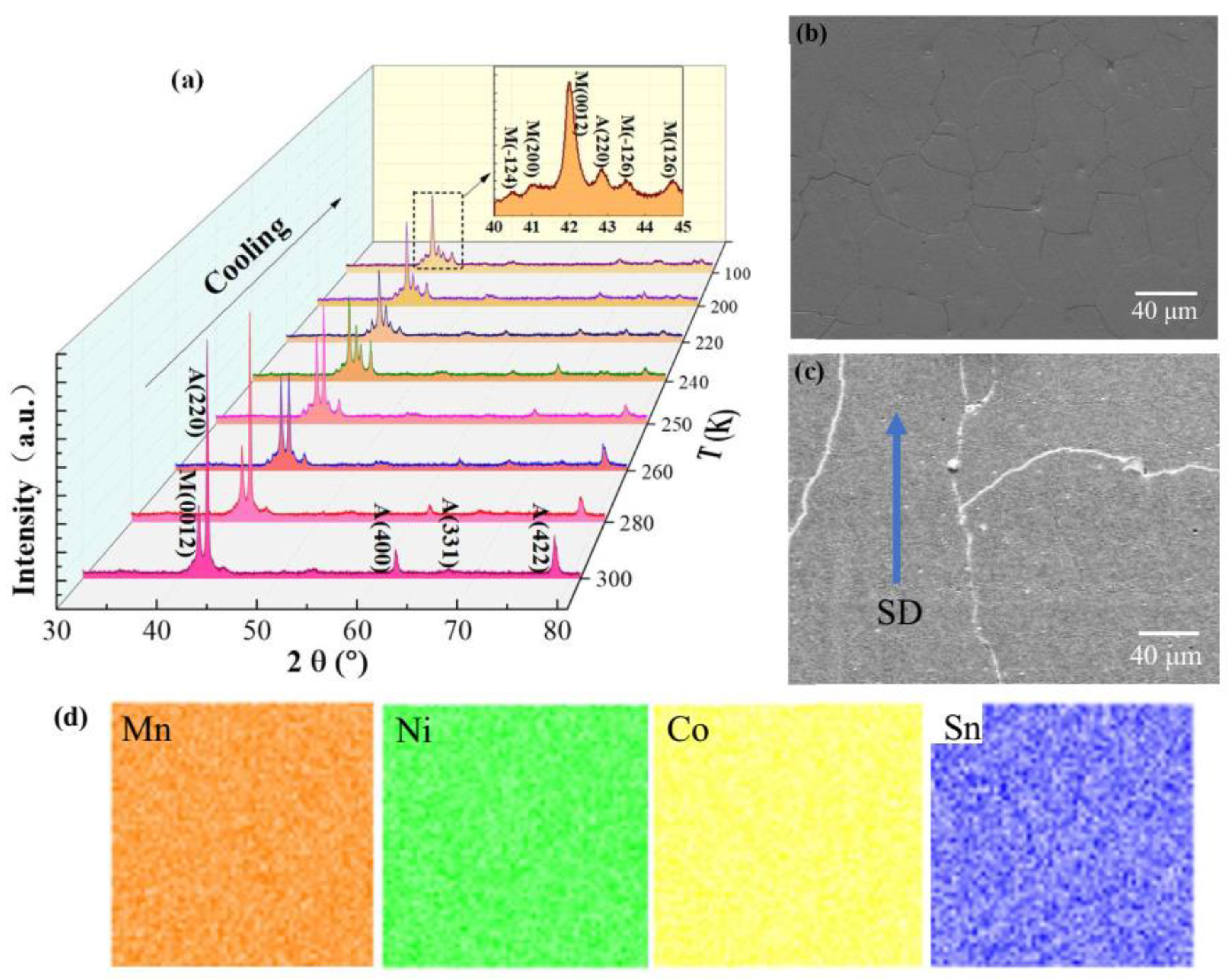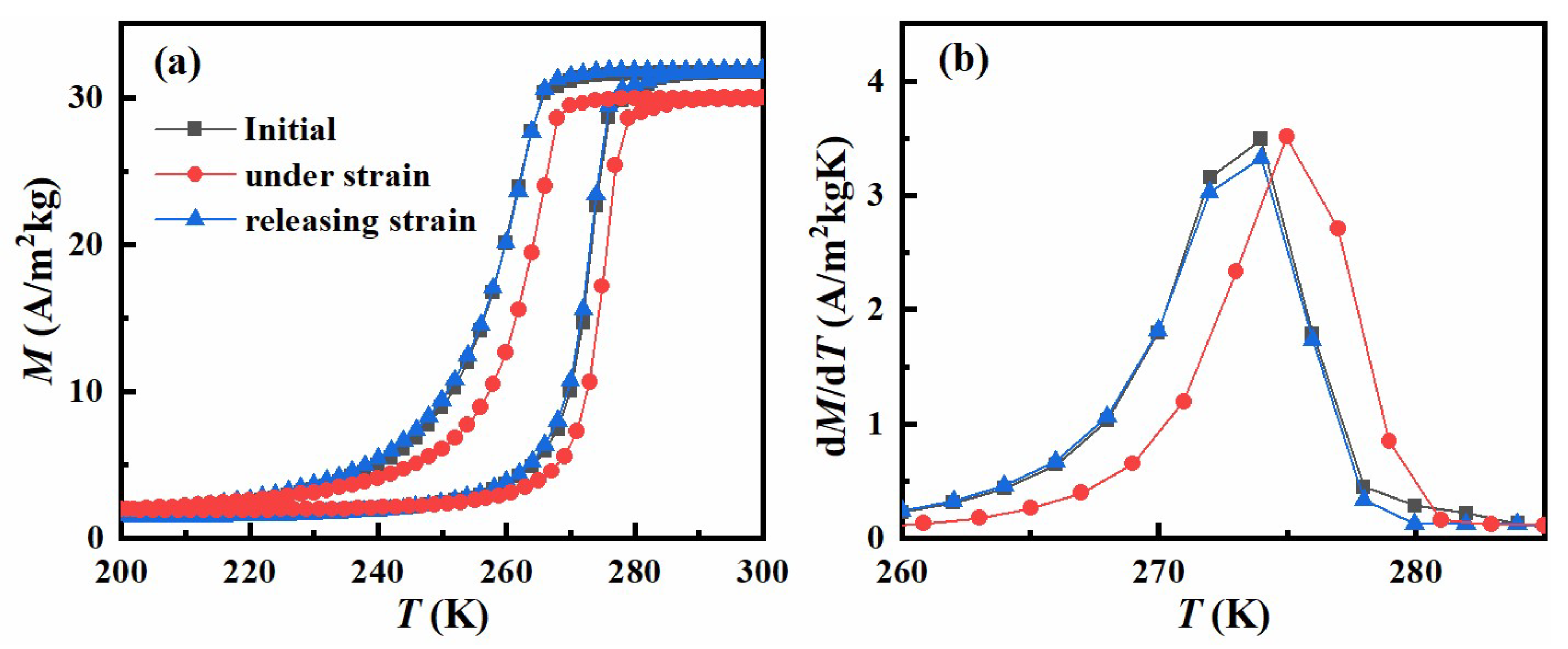Regulation of Magnetocaloric Effect in Ni40Co10Mn40Sn10 Alloys by Using a Homemade Uniaxial Strain Pressure Cell
Abstract
:1. Introduction
2. Methods
3. Results and Discussion
4. Conclusions
Author Contributions
Funding
Data Availability Statement
Conflicts of Interest
References
- Pecharsky, V.K.; Gschneidner, K.A. Giant Magnetocaloric Effect in Gd5Si2Ge2. Phys. Rev. Lett. 1997, 78, 4494. [Google Scholar] [CrossRef]
- Fujita, A.; Fujieda, S.; Fukamichi, K.; Mitamura, H.; Goto, T. Itinerant-electron metamagnetic transition and large magnetovolume effects in La(FexSi1−x)13 compounds. Phys. Rev. B 2001, 65, 014410. [Google Scholar] [CrossRef]
- Hu, F.X.; Shen, B.G.; Sun, J.R.; Cheng, Z.H.; Rao, G.H.; Zhang, X.X. Influence of negative lattice expansion and metamagnetic transition on magnetic entropy change in the compound LaFe11.4Si1.6. Appl. Phys. Lett. 2001, 78, 3675. [Google Scholar] [CrossRef]
- Tegus, O.; Bruck, E.; Buschow, K.H.J.; Boer, F.R.D. Transition-metal-based magnetic refrigerants for room-temperature applications. Nature 2002, 415, 150. [Google Scholar] [CrossRef]
- Romanini, M.; Wang, Y.; Gurpinar, K.; Ornelas, G.; Lloveras, P.; Zhang, Y.; Zheng, W.; Barrio, M.; Aznar, A.; Gracia-Condal, A.; et al. Giant and Reversible Barocaloric Effect in Trinuclear Spin-Crossover Complex Fe3(bntrz)6 (tcnset)6. Adv. Mater. 2021, 33, 2008076. [Google Scholar] [CrossRef]
- Liu, J.; Gottschall, T.; Skokov, K.P.; Moore, J.D.; Gutfleisch, O. Giant magnetocaloric effect driven by structural transitions. Nat. Mater. 2012, 11, 620. [Google Scholar] [CrossRef]
- Moya, X.; Mathur, N.D. Caloric materials for cooling and heating. Science 2020, 370, 797. [Google Scholar] [CrossRef]
- Zarkevich, N.A.; Zverev, V.I. Viable Materials with a Giant Magnetocaloric Effect. Crystals 2020, 10, 815. [Google Scholar] [CrossRef]
- Mañosa, L.; Planes, A. Solid-state cooling by stress: A perspective. Appl. Phys. Lett. 2020, 116, 050501. [Google Scholar] [CrossRef]
- Tušek, J.; Engelbrecht, K.; Millán-Solsona, R.; Mañosa, L.; Vives, E.; Mikkelsen, L.P.; Pryds, N. The Elastocaloric Effect: A Way to Cool Efficiently. Adv. Energy Mater. 2015, 5, 1500361. [Google Scholar] [CrossRef]
- Zhou, H.; Long, Y.; Miraglia, S.; Porcher, F.; Zhang, H. Age stability of La(Fe,Si)13 hydrides with giant magnetocaloric effects. Rare Met. 2022, 41, 992. [Google Scholar] [CrossRef]
- Franco, V.; Blázquez, J.S.; Ipus, J.J.; Law, J.Y.; Moreno-Ramírez, L.M.; Conde, A. Magnetocaloric effect: From materials research to refrigeration devices. Prog. Mater. Science 2018, 93, 112. [Google Scholar] [CrossRef]
- Gong, Y.Y.; Wang, D.H.; Cao, Q.Q.; Liu, E.K.; Liu, J.; Du, Y.W. Electric field control of the magnetocaloric effect. Adv. Mater. 2015, 27, 801. [Google Scholar] [CrossRef] [PubMed]
- Qiao, K.M.; Wang, J.L.; Hu, F.X.; Li, J.; Zhang, C.; Liu, Y.; Yu, Z.B.; Gao, Y.H.; Su, J.; Shen, F.R.; et al. Regulation of phase transition and magnetocaloric effect by ferroelectric domains in FeRh/PMN-PT heterojunctions. Acta Mater. 2020, 191, 51. [Google Scholar] [CrossRef]
- Qiao, K.M.; Zuo, S.L.; Zhang, H.; Hu, F.X.; Yu, Z.Y.; Weng, F.; Liang, Y.H.; Zhou, H.B.; Long, Y.; Wang, J.; et al. Electric field control of the reversible magnetocaloric effect in strain-mediated Ni37.5Co12.5Mn35Ti15/PMN-PT composite. Scripta Mater. 2021, 204, 114141. [Google Scholar] [CrossRef]
- Lovell, E.; Pereira, A.M.; Caplin, A.D.; Lyubina, J.; Cohen, L.F. Dynamics of the First-Order Metamagnetic Transition in Magnetocaloric La(Fe,Si)13: Reducing Hysteresis. Adv. Energy Mater. 2015, 5, 1401639. [Google Scholar] [CrossRef]
- Qiao, K.M.; Hu, F.X.; Liu, Y.; Li, J.; Kuang, H.; Zhang, H.R.; Liang, W.H.; Wang, J.; Sun, J.R.; Shen, B.G. Novel reduction of hysteresis loss controlled by strain memory effect in FeRh/PMN-PT heterostructures. Nano Energy 2019, 59, 285. [Google Scholar] [CrossRef]
- Yu, Z.Y.; Zhang, H.N.; Zhou, H.; Cong, D.Y.; Taskaev, S.V.; Liu, E.K.; Zhang, H. Martensitic transformation behaviors of all-d-metal Heusler Mn50Ni50−x−yFexTiyalloys (in Chinese). Sci. Sin-Phys. Mech. Astron. 2021, 51, 067512. [Google Scholar] [CrossRef]
- Liu, F.X.; Zhang, H.; Zhou, H.; Cong, D.Y.; Huang, R.J.; Wang, L.C.; Long, Y. Successive inverse and normal magnetocaloric effects in the Mn-vacancy compound Mn0.95Co0.75Cu0.25Ge. Sci. Sin-Phys. Mech. Astron. 2020, 63, 277511. [Google Scholar] [CrossRef]
- Chen, J.H.; Chhetri, T.P.; Chang, C.K.; Huang, Y.C.; Young, D.P.; Dubenko, I.; Talapatra, S. Ali N, Stadler S, The influence of hydrostatic pressure and annealing conditions on the magnetostructural transitions in MnCoGe. J. Appl. Phys. 2021, 129, 215108. [Google Scholar] [CrossRef]
- Chen, J.H.; Trigg, A.; Chhetri, T.P.; Young, D.P.; Dubenko, I.; Ali, N.; Stadler, S. The influence of Au substitution and hydrostatic pressure on the phase transitions and magnetocaloric properties of MnCoGe alloys. J. Appl. Phys. 2020, 127, 213901. [Google Scholar] [CrossRef]
- Lloveras, P.; Samanta, T.; Barrio, M.; Dubenko, I.; Ali, N.; Tamarit, J.L.; Stadler, S. Giant reversible barocaloric response of (MnNiSi)(1-x)(FeCoGe)x (x = 0.39, 0.40, 0.41). APL Mater. 2019, 7, 061106. [Google Scholar] [CrossRef] [Green Version]
- Stern-Taulats, E.; Castán, T.; Planes, A.; Lewis, L.H.; Barua, R.; Pramanick, S.; Majumdar, S.; Mañosa, L. Giant multicaloric response of bulk Fe49Rh51. Phys. Rev. B 2017, 95, 104424. [Google Scholar] [CrossRef]
- Qu, Y.H.; Cong, D.Y.; Li, S.H.; Gui, W.Y.; Nie, Z.H.; Zhang, M.H.; Ren, Y.; Wang, Y.D. Simultaneously achieved large reversible elastocaloric and magnetocaloric effects and their coupling in a magnetic shape memory alloy. Acta Mater. 2018, 151, 41. [Google Scholar] [CrossRef]
- Gràcia-Condal, A.; Gottschall, T.; Pfeuffer, L.; Gutfleisch, O.; Planes, A.; Mañosa, L. Multicaloric effects in metamagnetic Heusler Ni-Mn-In under uniaxial stress and magnetic field. Appl. Phys. Rev. 2020, 7, 041406. [Google Scholar] [CrossRef]
- Hu, Y.; Li, Z.B.; Yang, B.; Qian, S.X.; Gan, W.M.; Gong, Y.Y.; Li, Y.; Zhao, D.W.; Liu, J.; Zhao, X.; et al. Combined caloric effects in a multiferroic Ni–Mn–Ga alloy with broad refrigeration temperature region. APL Mater. 2017, 5, 046103. [Google Scholar] [CrossRef] [Green Version]
- Shen, Y.; Wei, Z.Y.; Sun, W.; Zhang, Y.F.; Liu, E.K.; Liu, J. Large elastocaloric effect in directionally solidified all-d-metal Heusler metamagnetic shape memory alloys. Acta Mater. 2020, 188, 677. [Google Scholar] [CrossRef]
- Li, Z.Z.; Li, Z.B.; Li, D.; Yang, J.J.; Yang, B.; Hu, Y.; Wang, D.H.; Zhang, Y.D.; Esling, C.; Zhao, X.; et al. Achieving a broad refrigeration temperature region through the combination of successive caloric effects in a multiferroic Ni50Mn35In15 alloy. Acta Mater. 2020, 192, 52–59. [Google Scholar] [CrossRef]
- Zhang, H.; Xing, C.F.; Zhou, H.; Zheng, X.Q.; Miao, X.F.; He, L.H.; Chen, J.; Lu, H.; Liu, E.K.; Han, W.T.; et al. Giant anisotropic magnetocaloric effect by coherent orientation of crystallographic texture and rare-earth ion moments in HoNiSi ploycrystal. Acta Mater. 2020, 193, 210. [Google Scholar] [CrossRef]
- Muthu, S.E.; Rao, N.V.R.; Raja, M.M.; Arumugam, S.; Matsubayasi, K.; Uwatoko, Y. Hydrostatic pressure effect on the martensitic transition, magnetic, and magnetocaloric properties in Ni50−xMn37+xSn13 Heusler alloys. J. Appl. Phys. 2011, 110, 083902. [Google Scholar] [CrossRef]
- Caron, L.; Ou, Z.Q.; Nguyen, T.T.; Thanh, D.T.C.; Tegus, O.; Brück, E. On the determination of the magnetic entropy change in materials with first-order transitions. J. Magn. Magn. Mater. 2009, 321, 3559. [Google Scholar] [CrossRef]
- Griffith, L.D.; Mudryk, Y.; Slaughter, J.; Pecharsky, V.K. Material-based figure of merit for caloric materials. J. Appl. Phys. 2018, 123, 034902. [Google Scholar] [CrossRef]
- Russek, S.L.; Zimm, C.B. Potential for cost effective magnetocaloric air conditioning systems. Int. J. Refrig. 2006, 29, 1366. [Google Scholar] [CrossRef]
- Hou, H.L.; Qian, S.X.; Takeuchi, I. Materials, physics and systems for multicaloric cooling. Nat. Rev. Mater. 2022. [CrossRef]





Publisher’s Note: MDPI stays neutral with regard to jurisdictional claims in published maps and institutional affiliations. |
© 2022 by the authors. Licensee MDPI, Basel, Switzerland. This article is an open access article distributed under the terms and conditions of the Creative Commons Attribution (CC BY) license (https://creativecommons.org/licenses/by/4.0/).
Share and Cite
Qiao, K.; Liang, Y.; Zuo, S.; Zhang, C.; Yu, Z.; Long, Y.; Hu, F.; Shen, B.; Zhang, H. Regulation of Magnetocaloric Effect in Ni40Co10Mn40Sn10 Alloys by Using a Homemade Uniaxial Strain Pressure Cell. Materials 2022, 15, 4331. https://doi.org/10.3390/ma15124331
Qiao K, Liang Y, Zuo S, Zhang C, Yu Z, Long Y, Hu F, Shen B, Zhang H. Regulation of Magnetocaloric Effect in Ni40Co10Mn40Sn10 Alloys by Using a Homemade Uniaxial Strain Pressure Cell. Materials. 2022; 15(12):4331. https://doi.org/10.3390/ma15124331
Chicago/Turabian StyleQiao, Kaiming, Yuhang Liang, Shulan Zuo, Cheng Zhang, Ziyuan Yu, Yi Long, Fengxia Hu, Baogen Shen, and Hu Zhang. 2022. "Regulation of Magnetocaloric Effect in Ni40Co10Mn40Sn10 Alloys by Using a Homemade Uniaxial Strain Pressure Cell" Materials 15, no. 12: 4331. https://doi.org/10.3390/ma15124331




